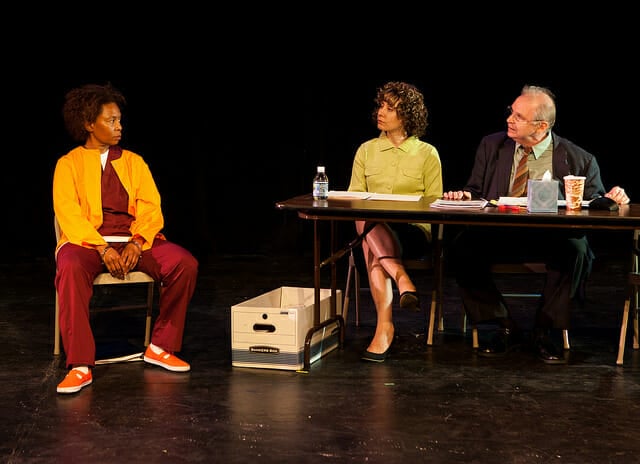Battered Women Behind Bars: True Stories on Stage

“Abuse is a generic term, it doesn’t mean anything,” the parole board commissioner says. “Be specific.”
Helen Broker sits in handcuffs at the hearing and prepares to defend herself. Her husband had violently abused her throughout their marriage, until one day, acting in self-defense, she killed him. She has now served eleven of her fifteen-years-to-life sentence. She feels both the hope and the pressure of the chance of being released from prison, her potential freedom only hours away. But to communicate the realities of domestic violence and explain her actions to the parole board committee proves to be arduous at every turn.
This quandary drives the plot of Life Without Parole, a play currently showing at the New York International Fringe Festival. The trauma is real, and the drama nonfictional. Inspired by the documentary Sin By Silence and the late Dr. Elizabeth Leonard’s book Convicted Survivors: The Imprisonment of Battered Women Who Kill, playwright Warren Doody drew on Dr. Leonard’s original testimonies of forty-two incarcerated women at the California Institution for Women at Chino (CIW). The current production, directed by Jessica Dermody and produced by Karah Gravatt, made its east coast premiere at Manhattan Repertory Theatre this January.
In between the parole board committee’s brusque questioning, the audience gradually learns about Helen’s life history and the harrowing cycles of psychological and physical violence she has endured since a young age. Other voices form a chorus; young and old, the women tell their own stories and add on to the others like interweaving melodies. Their faces, only feet away from the audience, are unforgettable yet ordinary—they could be anyone.
We rarely see a smile or hear a snicker, except when the women recount and scoff at the authorities’ misguided remarks that reveal their ignorance about domestic violence. Most of the time, the voices of the chorus face the audience directly, their expressions pain-stricken and their words raw and haunting. The women’s camaraderie, and powerful individual narratives, are punctured by scenes at the parole board hearing, where the board wields its unique kind of power.
The stage is set minimally, with lighting changes or prison alarms used to switch between fluid and often overlapping scenes. But this dramatization only brings the stories closer to reality. As assistant director Kasey Brown put it, the audience’s “sick realization that there are actual women in prison with these stories,” is what gives the play its impact.
The parole board wants—or believes it needs—“specifics” to review Helen’s suitability for parole, but mere words won’t cut it. Sitting before her inquisitors, Helen once again has to tap into some of her most acutely traumatic memories and present them as objective evidence. The authorities demand to know why she didn’t think more “rationally” before acting, searching for culpability in a battered woman whose life is being threatened. To the parole board, the complexities of trauma appear only as contradictions.
Holding on to Helen’s file, the parole board’s assessment of Helen’s actions is informed mostly by her past records—and only hers. The original criminal, her husband, is a glaring omission in the conversation. The board concludes that while her criminal history is minimal, she has an “unstable social history” (to which someone in the audience of one performance let out a startled “huh!”) that ultimately turns the cyclical pattern of assault and trauma Helen sustained throughout her life against her. The frustration Helen feels in not being able to present her point of view is palpable. Communication between Helen and the board is impossible; but privy to her full story, the audience is transfixed.
The criminal justice system has never been fully prepared to handle cases of domestic abuse, nor is it a pioneer of interventions any more transformative than prison time, which is precisely what Life Without Parole demonstrates. According to the National Clearinghouse for the Defense of Battered Women, federal statistics show that 55 percent of incarcerated women have experienced physical or sexual abuse in their lifetimes, and 68 percent of those were harmed by an intimate partner; more in-depth research suggests that figure could be as high as 90 percent or more (PDF).
Life Without Parole started out as a series of staged readings in California and Arizona in 2003. In 2004, in a first of its kind performance inside the prison where the testimonies had been collected, actors spoke the women’s own words back to the incarcerated domestic violence survivors themselves who were in the audience. “One of the things [the play does is] it demonstrates that the audience, the women, the inmates have not been forgotten about,” says playwright Warren Doody.
The producers of Life Without Parole warn us that the play is “akin to Greek tragedy insofar as it carries the unmistakable stamp of inevitability.” But this play helps us understand at a visceral level the ways in which intimate injuries meet systemic dysfunction.
Life Without Parole is playing on Aug. 21 and Aug. 23 at Teatro LATEA at the Clemente as part of the New York International Fringe Festival.